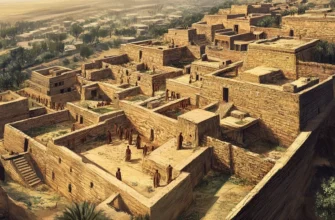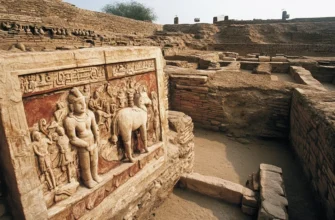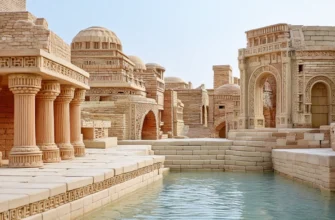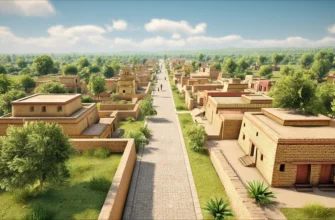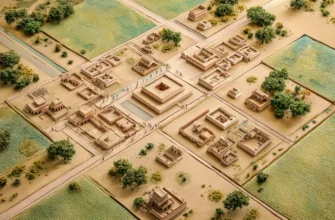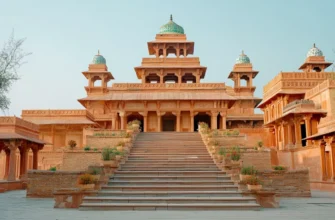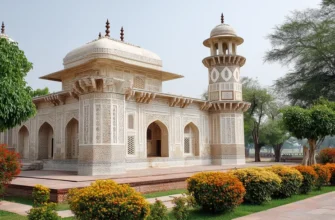Medicine in ancient India was closely linked to philosophy, religion, and natural sciences. The basis of medical knowledge was Ayurveda, a system of healing based on harmony between body, mind, and spirit. Medical knowledge was passed down in sacred texts, including the Atharva Veda, Charaka Samhita, and Sushruta Samhita. Doctors (vaidyas) diagnosed diseases by the pulse, speech, eyes, and urine, and used herbs, minerals, massage, yoga, and special diets for treatment.
One of the most prominent doctors was Sushruta, who is called the “father of surgery.” In his works, he described over 300 surgical procedures and the use of over 120 medical instruments. In ancient India, plastic surgery was already being performed, fractures were treated, and even amputations were carried out.
Special attention was paid to hygiene and sanitation.
Regular water treatments, clean cities, and the use of natural antiseptics helped prevent disease. India had the first hospitals where patients received medical care. Ayurveda and the surgical practices of ancient India influenced the development of medicine in other civilizations.
Their knowledge was passed on through Persian, Arabic, and European sources, and today Ayurveda remains an important part of alternative medicine. Ancient Indian medicine was ahead of its time and laid the foundations for many modern methods of treatment.
- The basics of ancient Indian medicine
- Ayurveda – the science of life and health
- Sources of medical knowledge
- The role of doctors (vaidya)
- Diagnosis and treatment methods
- Surgery in Ancient India
- Sushruta’s contribution to medicine
- Surgical instruments of ancient doctors
- Wound disinfection methods
- Hygiene and sanitation
- Public sanitation
- The influence of ancient Indian medicine on the world
- Conclusion
The basics of ancient Indian medicine
The foundations of ancient Indian medicine were based on the concept of harmony between body, mind, and spirit. Ayurveda, the oldest system of healing based on the doctrine of the three doshas: vata, pitta, and kapha, which determined a person’s physiological state, occupied a central place in healing practices. It was believed that diseases arise from an imbalance of these energies, and treatment should be aimed at restoring this balance.
The main medical knowledge is set out in the sacred texts – the Atharva Veda, the Charaka Samhita, and the Sushruta Samhita. These treatises described in detail diagnostic methods, the use of medicinal plants, therapeutic practices, and surgical interventions. Doctors (vaidyas) diagnosed diseases based on the patient’s appearance, pulse, speech, body odor, and urine.
Treatment in ancient India included herbal medicine, mineral preparations, cleansing procedures (panchakarma), massage, yoga, diet therapy, and meditation. Great attention was paid to disease prevention through proper nutrition, hygiene, and emotional balance.
In addition to therapy, surgery played an important role. Sushruta, one of the most famous doctors of ancient India, described more than 300 surgical procedures, including reconstructive surgery, removal of stones from the bladder, and even amputations. His work contained detailed descriptions of over 120 medical instruments used for complex operations.
Hygiene and sanitation were considered important components of medicine. Daily water procedures, thorough body care, the use of natural antiseptics, and clean living quarters helped prevent disease. India had the first hospitals where patients were provided with medical care using both natural remedies and surgical methods.
Ancient Indian medicine was far ahead of its time, laying the foundations for future medical knowledge and influencing the development of medicine in other civilizations.
Ayurveda – the science of life and health
Ayurveda is an ancient Indian system of medicine, meaning “science of life” (from the Sanskrit words ayus – ‘life’ and veda – “knowledge”).
It has been developed over thousands of years and is based on the harmony between body, mind, and spirit. Ayurveda views the human being as a holistic system, and its health depends on the balance of three vital energies, or doshas:
Vata (air and ether) – responsible for movement and the nervous system.
Pitta (fire and water) controls metabolism and body temperature.
Kapha (water and earth) affects body structure and stability.
According to Ayurveda, diseases arise from an imbalance of doshas, so treatment is aimed at restoring this balance. The main methods include herbal medicine, proper nutrition, yoga, massage, meditation, cleansing procedures (panchakarma), and spiritual practices. Ancient Indian treatises Charaka Samhita and Sushruta Samhita contain detailed descriptions of diagnostic methods and treatments. Doctors determined the patient’s condition by their pulse, speech, eyes, skin, and even body odor.
Ayurveda emphasizes disease prevention through adherence to a daily routine, seasonal recommendations, and a healthy lifestyle. It remains relevant today, combining ancient knowledge with modern scientific approaches to medicine.
Sources of medical knowledge
Ancient Indian medicine was based on sacred texts and treatises containing systematic knowledge about the treatment, prevention, and diagnosis of diseases. The main sources of medical knowledge were the Vedas, in particular the Atharva Veda, as well as the classical medical texts Charaka Samhita and Sushruta Samhita.
The Atharva Veda (approximately 2nd millennium BCE) contained the first references to herbal treatment, incantations for expelling diseases, and sanitary practices. It laid the foundations for future Ayurvedic medicine, focusing on prevention and cleansing of the body.
Charaka Samhita (approximately 1st millennium BC) is one of the most important Ayurvedic treatises, describing the principles of diagnosis, treatment, and healthy lifestyle. It contains knowledge about the balance of the three doshas (vata, pitta, kapha), the importance of nutrition, mental health, and the influence of the environment on the body.
The Sushruta Samhita is attributed to the physician Sushruta and is the main source of knowledge on surgery. It describes in detail more than 300 surgical procedures, methods of anesthesia, the anatomical structure of the body, and principles of wound disinfection. This text became the basis for the development of surgery in world medicine.
In addition to these treatises, medical knowledge was passed down orally from teacher to student and preserved in monasteries and educational centers such as Taxila and Nalanda. These sources became the foundation for the further development of medicine not only in India but throughout the world.
The role of doctors (vaidya)
Doctors in ancient India, called vaidya, played a key role in the development of medicine and health care. They were considered not just healers, but bearers of profound knowledge about the human body, nature, and spiritual balance.
Vaidya studied at medical centers such as Taxila and Nalanda, and their training was based on sacred texts, including the Charaka Samhita and Sushruta Samhita. In addition to theoretical knowledge, future doctors gained practical experience by studying anatomy through dissections and observing the procedures of experienced mentors.
Vaidya diagnostic methods included examining the patient, analyzing their pulse, speech, eyes, body odor, and even urine. They treated illnesses with herbs, minerals, cleansing procedures, massage, yoga, special diets, and meditation. Vaidya also performed surgical operations, including tumor removal, fracture treatment, and even plastic surgery.
Doctors adhered to high moral standards and viewed medicine as a sacred mission. They were not only experts in Ayurveda, but also mentors who helped people maintain balance between body and spirit. Thanks to their knowledge and practices, the medicine of Ancient India was far ahead of its time and influenced the development of healing traditions in other civilizations.
Diagnosis and treatment methods
Ancient Indian medicine used a comprehensive approach to diagnosis, based on observation of the patient’s body, behavior, and physiological indicators. Vaidya (doctors) believed that each organism is unique and that diseases arise from an imbalance of the three vital energies—dosha: vata, pitta, and kapha.
Diagnostic methods
Doctors in ancient India did not have modern equipment, so they used careful examination and various tests to determine the patient’s state of health
Pulse examination (nadi pariksha) was considered one of the main diagnostic methods, as the pulse rhythm reflected the balance of the doshas.
Tongue examination – the color, coating, and texture were used to identify digestive problems and overall health.
Examination of the eyes, skin, nails, and hair – their appearance could indicate internal diseases and nutrient deficiencies.
Body odor, urine, and sweat – specific odors were considered signs of various pathologies.
Urine and stool analysis – color and consistency helped diagnose digestive and metabolic problems.
Psychological state – Vaidya took into account the patient’s emotional state, as the psyche influenced physical health.
Treatment methods
Treatment in ancient India was multifaceted and combined physical, psychological, and spiritual practices.
Phytotherapy was the main method of treatment, which included the use of medicinal plants, roots, minerals, and spices. Turmeric, ginger, ashwagandha, and triphala were the most common remedies.
Cleansing procedures (panchakarma) were special methods for detoxifying the body, including oil massages, sweating, enemas, and vomiting procedures.
Nutritional therapy was considered the best medicine. Vaidyas prescribed individual diets depending on the patient’s dosha type.
Yoga and breathing practices (pranayama) – helped restore energy, strengthen the body, and treat various diseases.
Meditation and mantras – were used to reduce stress, strengthen mental health, and harmonize consciousness.
Aromatherapy and oils – essential oils and incense helped treat nervous disorders, breathing problems, and skin diseases.
Surgery – under the guidance of Sushruta, eye surgery, stone removal, plastic surgery, and fracture treatment were performed.
Treatment was always tailored to the individual, taking into account lifestyle, climatic conditions, and the internal state of the person. Thanks to this approach, ancient Indian medicine became the basis for many modern methods of treatment.
Surgery in Ancient India
Surgery in Ancient India was highly developed and was an important part of the medical knowledge of the time.
The basics of Indian surgery are laid out in classic texts like the Sushruta Samhita, written by the great doctor and surgeon Sushruta around 600 BCE. This treatise is one of the oldest medical documents in the world and describes a wide range of surgical procedures, treatment methods, and tools.
Key aspects of surgery in ancient India:
Surgical instruments: Indian surgeons used a variety of instruments similar to modern scalpels, scissors, tweezers, and needles. These were made from metal, stone, or bone.
Operations: Sushruta describes more than 300 types of operations, including operations on the eyes, nose, bones, and skin. For example, he discusses plastic surgery in detail, including nose reconstruction after amputation, which shows the high skill of Indian surgeons at that time.
Anesthesia: Ancient Indians also knew about methods of pain relief. They used herbal preparations such as opium, alcohol, and other plant extracts to achieve anesthesia during operations.
Infections: Despite their lack of knowledge about bacteria, Indian doctors were aware of the importance of hygiene and cleanliness during operations. They used various disinfectants, such as honey and other antiseptics.
Importance of education: In ancient India, doctors were educated through practical training and apprenticeships in hospitals and medical schools. Sushruta emphasized the importance of skill and experience for a doctor, as well as the need for knowledge of anatomy and physiology.
Thanks to these achievements, Indian surgery had a significant influence on the development of medical knowledge in the world, particularly in Arab and European countries in the Middle Ages.
Sushruta’s contribution to medicine
Sushruta, a great physician and surgeon of ancient India, made a significant contribution to the development of medicine, especially in the field of surgery. His main achievement is the work “Sushruta Samhita,” one of the oldest medical books describing operations, medical instruments, treatment techniques, and the principles of a doctor’s work.
In this work, Sushruta describes more than 300 types of operations, including surgical interventions on the skin, eyes, and nose, as well as reconstructive operations, in particular operations on the nose after its amputation, which became the basis for the development of plastic surgery in the future.
Sushruta also developed various surgical instruments, including scalpels, tweezers, scissors, and needles, which were used during operations. He also paid great attention to hygiene during surgical procedures, promoting the sterility of instruments and the cleanliness of the conditions in which operations were performed. One of Sushruta’s innovative approaches was the use of anesthesia with natural preparations such as alcohol and opium.
Sushruta not only practiced medicine, but also actively passed on his knowledge to future generations of doctors, emphasizing the importance of training and experience. His approaches to treatment and surgery became the basis for medical schools in India and also had a significant influence on Arab and European medicine in the Middle Ages.
In addition to surgery, Sushruta studied other aspects of medicine, including the treatment of injuries, skin diseases, inflammation, and the use of plants to treat various diseases. His works have made a significant contribution to the development of medical knowledge and treatment methods that are still preserved and used today.
Surgical instruments of ancient doctors
Surgical instruments used by ancient doctors in ancient India, particularly those described in Sushruta’s works, were an important part of medical practice and often served a similar role to modern surgical instruments. The Sushruta Samhita describes in detail the various instruments used for different surgical operations. Although these instruments differed significantly from those used today, their precision and specialization are impressive. Here are some of the instruments used by ancient Indian physicians:
Scalpel
Scalpels were probably the most common instruments used for making incisions. They were used to make precise cuts in the skin and soft tissues. Scalpels were made of metal, and their blades were very sharp to minimize tissue damage.
Scissors
Scissors were used to cut tissue, such as soft tissue or blood vessels. They came in different sizes and shapes depending on the type of operation they were intended for.
Tweezers
Tweezers were used to grasp small objects or tissue particles, such as sutures, wounds, or foreign bodies that had entered the patient’s body. They were also used to remove stones from the urinary tract or other organs.
Needles and suture thread
Needles were used to suture tissue after surgery. Special threads were made from natural materials such as silk, as well as from hard parts of plants, which provided sufficient strength to close wounds. This allowed wounds to be sutured and bleeding to be stopped.
Vascular clamps
These instruments were used to temporarily stop bleeding during surgery when it was necessary to clamp blood vessels to reduce bleeding before further steps could be taken.
Lancets
A lancet is a small knife used to make small incisions or to pierce tissue. It was useful for punctures or operations involving the removal of fluids or samples from organs.
Stones and metal instruments for trauma
Indian surgeons also used a variety of instruments to treat fractures, dislocations, and injuries. Stones and metal plates were used to fix bones after fractures, allowing them to heal properly.
Lancet for surgical procedures on the eyes
Sushruta described the use of special lancets for eye surgery, particularly for removing cataracts or cleaning out foreign objects.
Instruments for plastic surgery
Sushruta described plastic surgery in detail, including nose reconstruction. Special instruments were used to prepare and correct tissue, as well as techniques for nose plastic surgery.
Bone and wooden instruments
Some instruments used by ancient Indian surgeons were made of bone or wood, which allowed them to be used in cases where metal instruments were too expensive or difficult to manufacture.
The instruments of ancient Indian surgeons, although significantly different from modern ones, showed a high level of technical development and skill. They allowed complex surgical operations to be performed with minimal trauma to patients. Thanks to such instruments and methods, ancient Indian doctors were able to perform operations that amazed modern doctors with their complexity and precision.
Wound disinfection methods
Wound disinfection methods in ancient India were an important part of medical practice, and Sushruta, in his work “Sushruta Samhita,” described in detail various methods of treating wounds to prevent infection and facilitate the healing process. Although there was no knowledge of bacteria and microbes at the time, ancient Indian doctors still understood the importance of hygiene and used effective methods to reduce the risk of infection.
Use of natural antiseptics
Ancient Indian doctors used a variety of natural remedies that had antiseptic properties. These included:
Honey — one of the most common antiseptics. It had natural antibacterial properties and was used to treat wounds, helping to prevent infection and speed up healing.
Herbs and plant extracts — many herbs in ancient India had antiseptic properties. For example, turmeric, ginger, tulsi (holy basil), aralia (pepper), and nectar from various flowers were used to treat wounds because they helped reduce the risk of inflammation.
Clay and other natural materials — Some types of clay were also used to treat wounds because they could absorb toxins and reduce inflammation.
Warming and cooling
Sushruta described methods of warming and cooling wounds to prevent infection and relieve pain. Depending on the type of wound, warm or cold compresses could be applied to help reduce inflammation and facilitate the healing process.
Oils for wound treatment
Ancient Indian doctors also used various oils to treat wounds. These could be oils derived from plants, such as coconut or mustard oil, which had moisturizing and protective effects. They helped keep the skin in good condition and prevented it from drying out.
Cleanliness and hygiene
Sushruta emphasized the importance of maintaining cleanliness when treating wounds. Although there was no knowledge of microbes, doctors were aware that contamination of a wound could lead to infection. It was therefore important to use clean instruments and to thoroughly clean wounds before treating them.
Stopping bleeding
To prevent infection, it was important to stop bleeding, as blood could be a breeding ground for bacteria. Sushruta described methods of stopping bleeding by applying pressure, using forceps to grasp blood vessels, and using natural powders or “cauterization” to stop minor bleeding.
Bandaging techniques
After treating wounds, bandaging was an important part of treatment. Clean cloths were used for this purpose to ensure that the wound was covered tightly and prevented from becoming contaminated. Sushruta recommended bandaging wounds carefully to keep them protected from external influences.
Use of medicinal poultices and pastes
Paste-like mixtures based on herbs and plants were used to improve healing. These mixtures were applied to wounds to help reduce inflammation and speed up healing. They could contain powders from medicinal plants or their infusions, which acted as antiseptics.
“Open treatment” technique
Sometimes, depending on the nature of the wound, an “open treatment” technique was used, in which the wound was not bandaged for a long time so that it could be freely cleansed of pus and other contaminants. This technique helped prevent infection through constant treatment of the wound and its regular cleaning.
Wound disinfection methods in ancient India were quite advanced for their time and were successfully used to prevent infections and accelerate healing. Thanks to the use of natural antiseptics such as honey, vegetable oils, and herbs, as well as strict hygiene principles, Indian doctors were able to effectively treat wounds and injuries, even without modern knowledge of microbes and bacteria.
Hygiene and sanitation
Hygiene and sanitation in ancient India were important aspects of medical practice, even despite the lack of knowledge about microbes and bacteria, which only became known in modern times. Indian doctors and society in general already understood the importance of cleanliness and proper body care for maintaining health and preventing disease.
Personal hygiene
In ancient India, personal hygiene was an important aspect of everyday life and was given a lot of attention. Indians believed that cleanliness of the body and mind were interrelated, and that certain standards had to be followed to maintain physical and spiritual health.
Washing and bathing: In ancient India, regular washing was mandatory. People bathed in rivers such as the Ganges or used special pools and baths in their homes. Water was important not only for cleansing the body but also for cleansing the spirit.
Cleaning products: Various natural products were used to clean the body, such as powders made from plants (e.g., turmeric powder, wisteria, and other plant components), which were used for washing and killing bacteria, as well as for improving skin health.
Teeth cleaning: Teeth cleaning was also an important part of Indian hygiene. For this purpose, wooden sticks or wooden brushes made from certain types of trees with antiseptic properties were used.
Hygiene in medical practice
In medical practice, hygiene during surgical procedures was considered very important. Sushruta, in his work “Sushruta Samhita,” emphasized the need to maintain cleanliness during operations to prevent infections.
Cleanliness of instruments: Instruments used during operations had to be thoroughly cleaned. This included washing the instruments after each use and even disinfecting them with special natural agents.
Hand hygiene of doctors: Doctors had to wash their hands thoroughly before starting any procedures. Although it was not clear at the time why this was so important, it was believed to prevent the spread of disease.
Air and room cleanliness: During operations and procedures, doctors and patients tried to ensure that the air and rooms were clean. Given that unsanitary conditions were the cause of numerous infections, it was important not only to keep the instruments clean, but also the environment in which the operations were performed.
Sanitation in public places
Ancient India also had certain principles of sanitation to ensure cleanliness in public places, particularly in cities and settlements.
Sewage and water supply: Large cities in ancient India, such as Mohenjo-Daro and Harappa, had developed sewage and water supply systems.
Water was supplied through well-designed channels, and sewage was discharged through a system of pipes, ensuring a high level of hygiene.
Street cleanliness: Some cities also had rules for maintaining cleanliness in streets and public places. Special persons were often appointed to be responsible for cleaning and maintaining the streets in proper condition.
Sanitation in markets and canteens
Indians believed that food and its preparation should be kept clean to prevent disease. This issue was also given great importance, and strict rules existed to maintain hygiene in markets and canteens.
Food cleanliness: Foods such as vegetables, fruits, grains, meat, and milk had to be sold and stored in clean conditions to reduce the risk of contamination.
Cook hygiene: Cooks and traders had to maintain personal hygiene to prevent the spread of infections through food.
Sanitation in the treatment of disease
Cleanliness was also important in the treatment of infectious diseases. Sushruta recommended that wounds be thoroughly cleaned and kept clean to prevent the development of infections.
In ancient India, hygiene and sanitation were important aspects of daily life, reflecting a deep understanding of the connection between cleanliness, health, and well-being. Despite the lack of modern knowledge about microbes, Indians used natural remedies and had systems that helped maintain cleanliness in personal, medical, and public spheres, thus promoting the health of society.
Public sanitation
Public sanitation in ancient India was an important aspect of society, which included organizing cleanliness and ensuring proper conditions for the health of the population at the city and settlement levels. Since Indians had long understood the connection between cleanliness and health, many of these practices were carefully thought out and had a significant impact on people’s well-being.
Water supply and sewage systems
One of the greatest achievements in public sanitation in ancient India was the water supply and sewage system, which was first developed in cities such as Mohenjo-Daro and Harappa (Indus civilization). This testifies to the high level of infrastructure development in Indian cities:
Water supply: These cities had complex networks of water pipes that supplied water to homes and public buildings. Water was also supplied to public baths and ritual pools, providing the population with clean water.
Sewage: The ancient Indians had a well-developed sewage system that included underground pipes for the disposal of wastewater.
Water from city houses and public places was drained into specially constructed ditches or pipe systems, which kept the streets clean.
Cleanliness of streets and public places
In the cities of ancient India, great attention was also paid to the cleanliness of streets and public places. Special people were assigned to keep the streets clean.
Special workers: A system was set up where people were in charge of regularly cleaning streets and places where trash piled up to keep them from getting dirty.
Markets and trade: Market traders also had to follow rules regarding the cleanliness of their trading places and the storage of food. Food was sold in clean conditions to avoid contamination.
Hygiene in public buildings and structures
In ancient India, special attention was paid to hygiene in public buildings such as temples, markets, and places for food preparation and storage.
Temples and shrines: Indian temples often held purification rituals that included the use of clean water for washing, which helped maintain spiritual and physical cleanliness.
Public baths: In cities such as Mohenjo-Daro, there were public baths that were used for ritual washing but also served to maintain physical hygiene. This ensured the cleanliness of the population and prevented diseases associated with poor sanitation.
Waste collection and disposal
The ancient Indians also attached great importance to the proper collection and disposal of waste, especially in cities and settlements. Waste was not simply left on the streets, but was collected and recycled.
Garbage collection: Waste from homes and streets was regularly removed from the city by special services.
This prevented the accumulation of dirt, which could be a source of disease.
Waste collection systems: In large cities, there were special facilities for the collection of household waste, and this was organized by the relevant services to prevent environmental pollution.
Public education and hygiene rules
Indian society also paid attention to hygiene education, although there was no concept of germs and infections.
Educational programs: Training programs included hygiene instructions and recommendations for maintaining cleanliness in households, at work, and in public places.
Health care: Doctors such as Sushruta also emphasized the importance of hygiene and sanitation in the treatment of diseases and injuries. They gave recommendations on wound care and maintaining cleanliness during medical procedures.
Public sanitation in ancient India was very advanced for its time and included complex systems of water supply, sewage, street cleaning, and waste disposal. Indians understood the importance of cleanliness in preventing disease and maintaining the overall health of society. Responsibility for sanitation was entrusted to special individuals as well as to each member of the community. This helped to create a healthy environment that was conducive to the development of civilization.
The influence of ancient Indian medicine on the world
The influence of ancient Indian medicine on the world was enormous and multifaceted. Thanks to the significant achievements of Indian physicians such as Sushruta and Charaka, the Indian medical system, known as Ayurveda, had an important influence on the development of medicine in other cultures and even on modern medical practices. Here are some of the main aspects of this influence:
Fundamentals of surgery and anatomy
Ancient Indian medicine has significantly influenced the development of surgery and anatomy in many cultures:
Sushruta, known as the “father of surgery,” was considered one of the first doctors to describe human anatomy in detail and perform complex surgical procedures such as plastic surgery, amputations, eye surgery, and even surgery on nerve tissue. His work, Sushruta Samhita, became the basis for surgical practices in India and beyond.
His methods, including the use of surgical instruments and antiseptics, became the basis for further advances in surgery in India, the Middle East, and Europe. In particular, the plastic surgery methods he described for nose reconstruction were adapted in medieval medicine in Arab countries and later influenced European surgery.
Deepening knowledge of medicines and herbs
Indian doctors and pharmacists actively used medicinal plants with antiseptic and healing properties. They created numerous herbal infusions, pastes, and ointments that were used to treat various diseases. Many of these plants and treatments were passed on to other cultures:
Well-known medicinal herbs such as turmeric, tulsi (holy basil), ginger, and others were used to treat various diseases, including digestive problems, skin diseases, and to strengthen the immune system. This knowledge was passed on to other parts of Asia, particularly China and Arab countries, and eventually to Europe.
In the Arab world, many medical works, including those of Sushruta, were translated into Arabic in the Middle Ages and became the basis for the development of Arabic medicine. Doctors such as Ibn Sina (Avicenna) used Indian ideas to develop their own medical theories.
The Indian concept of health and well-being
Ayurveda, which became the basis of Indian medicine, is based on harmony between the body, mind, and spirit. This concept has influenced medical practices not only in India but also in many other cultures, including:
Holistic treatment. Ayurveda emphasizes disease prevention and harmony with nature. These ideas were also widespread in other medical traditions, particularly in Chinese and European systems. In particular, ideas about the importance of balance between body and mind were reflected in Western medical practices in the 20th century.
The Ayurvedic system of nutrition and detoxification has contributed to the development of alternative treatments such as herbal medicine, yoga, and meditation, which are now widely practiced around the world to support physical and mental health.
Transmission of knowledge through Arabic medicine
As mentioned earlier, numerous medical works, particularly on surgery and pharmacology, were translated into Arabic and became the main sources for the development of Arabic medicine. In particular, in the Middle Ages, doctors in the Middle East actively used Indian principles of treatment and even translated medical texts from Sanskrit into Arabic.
Ibn Sina (Avicenna), one of the greatest physicians of the Middle Ages, frequently referred to the works of Indian physicians and philosophers, including Sushruta and Charaka, in his work “The Canon of Medicine.”
Influence on medical systems of other cultures
The study and practice of ancient Indian medicine influenced the development of medical systems in various cultures:
In China, Indian medicine helped shape Chinese medicine through the exchange of knowledge about herbs and treatment methods.
Indian medicine became part of the medical traditions in Southeast Asia, particularly in Sri Lanka, Thailand, and Burma, where many principles of Ayurveda were adapted to local conditions.
Ideas from Indian medicine and its treatment methods were also adopted in the Roman Empire through contacts with trade routes connecting India with Europe.
Ancient Indian medicine has made an extremely important contribution to the development of world medicine. It laid the foundations for many modern medical practices, including surgery, herbal medicine, and a holistic approach to health and well-being. The knowledge and ideas that originated in India became important sources for the development of medical systems in other cultures and are still used today in alternative and traditional medicine around the world.
Conclusion
Ancient India made a significant contribution to the development of medicine, thanks to which numerous innovations and practices reached other cultures and continue to be used today. Indian medicine was not only theoretical but also practical, considering the development of surgery, anatomy, medicines, and disease prevention.
In particular, the works of doctors such as Sushruta and Charaka became the basis for the development of surgery and pharmacology. Ancient Indian physicians performed complex surgical operations, developed antiseptic methods, and used natural medicines that are still relevant in various medical traditions today. The principles of Ayurveda, which emphasize a holistic approach to health, have found their place in modern medicine thanks to modern methods of detoxification, yoga, meditation, and herbal medicine.
Ayurveda, which was the main medical system in ancient India, continues to be an important part of the world’s medical heritage. It has not only survived in India but has spread throughout the world, adapting to modern conditions. Today, Ayurvedic principles are used to support people’s physical, mental, and emotional well-being. Ayurvedic practices such as herbal medicine, massage, proper nutrition, and energy balance are actively used in both alternative medicine and traditional medical systems.
In the modern world, Ayurveda is gaining recognition for its approach to treatment through harmony with nature and its emphasis on disease prevention rather than just treating symptoms. It also promotes a purposeful and healthy lifestyle through prevention. An important aspect is the use of natural medicines and plants, which make it possible to reduce the side effects of traditional medicines.
Thus, the legacy of Ayurveda has not only been preserved but has become an important part of modern medical practices, helping people around the world maintain their health and live in harmony with themselves and nature.

